
Eudonia philerga is a species of moth of the family Crambidae. This species was first described by Edward Meyrick. It is endemic to New Zealand and is found throughout the country. E. philerga is regarded as being common. Larvae feed on moss and the adults have been observed on the wing more frequently from October to April. Adult moths are attracted to light.

Orocrambus flexuosellus is a species of moth in the family Crambidae. It was first described by Edward Doubleday in 1843. O. flexuosellus is endemic to New Zealand. It has been recorded from the North Island, South Island and the Stewart Islands. The species' habitat consists of lowland to alpine grasslands.

Eudonia submarginalis is a species of moth in the family Crambidae. It was described by Francis Walker in 1863. It is endemic to New Zealand.

Eudonia minualis is a species of moth of the family Crambidae. It was described by Francis Walker in 1866. It is endemic to New Zealand.
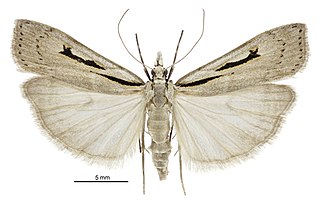
Scoparia rotuella is a species of moth in the family Crambidae. It was first described by Cajetan Felder, Rudolf Felder and Alois Friedrich Rogenhofer in 1875. It is endemic to New Zealand and, although considered localised, is found throughout the country. As at 2022 the life history of this species is largely unknown, but it has been hypothesised that this species may have two broods a year. Adults are on the wing all year round and are attracted to light.

Eudonia albafascicula is a moth of the family Crambidae. It was described by John Salmon in 1956. It is endemic to New Zealand, and can be found on Antipodes Island.
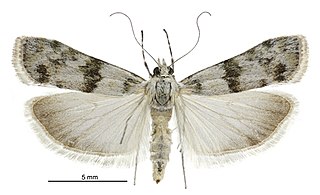
Eudonia asaleuta is a moth of the family Crambidae. It was described by Edward Meyrick in 1907. It is endemic to New Zealand and has been collected in the South Island in the West Coast, Fiordland,Canterbury, Otago and Southland regions. This species inhabits bare shingle areas as well as tussock habitat with few trees or scrub at altitudes of under 1000 m. Adults are on the wing from November to February.

Scoparia illota is a species of moth in the family Crambidae. It is endemic to New Zealand. The larvae of this species are leaf miners.
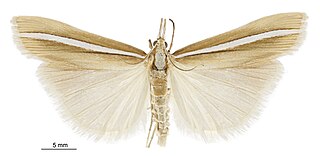
Orocrambus crenaeus is a moth in the family Crambidae. It was described by Edward Meyrick in 1885. It is endemic to New Zealand, where it is known from the South Island. The habitat consists of alpine grasslands.
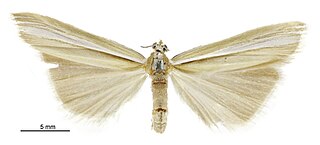
Orocrambus lectus is a moth in the family Crambidae. It was described by Alfred Philpott in 1929. It is endemic to New Zealand, where it has been recorded from Fiordland and north-western Nelson. The habitat of this species consists of subalpine and alpine areas. Adults have been recorded from December to February. Adults of this moth are known to pollinate Olearia virgata.

Glaucocharis pyrsophanes is a moth in the family Crambidae. It was described by Edward Meyrick in 1882. It is endemic to New Zealand. Adults of this moth are known to pollinate Leptospermum scoparium and Helichrysum selago.
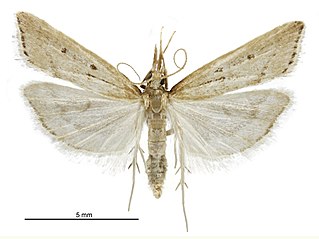
Antiscopa elaphra is a moth in the family Crambidae. It is endemic to New Zealand and has been observed in both the North and South Islands. Adults of this species are on the wing from August until March and are attracted to light. In 2020 this species had its DNA barcode sequenced.

Eudonia aspidota is a moth in the family Crambidae. It is found in New Zealand and can be found in the North, South and Stewart Islands. The species inhabits native forest and its larvae lives on mosses.
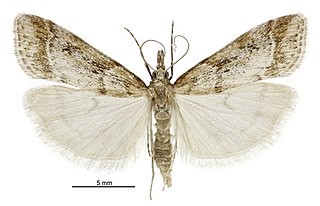
Eudonia chalara is a moth in the family Crambidae. It was described by Edward Meyrick in 1901. It is endemic to New Zealand.
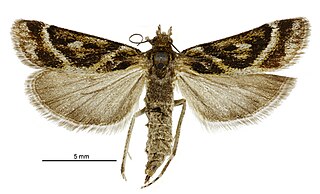
Eudonia xysmatias is a moth in the family Crambidae. It was first described by Edward Meyrick in 1907. This species is endemic to New Zealand and has been observed and collected in Otago. This species inhabits wetlands. Adults are day flying and are on the wing in December and January.
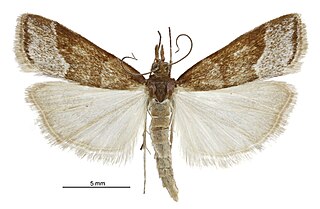
Eudonia feredayi is a moth in the family Crambidae. It was described by Henry Guard Knaggs in 1867. This species is endemic to New Zealand.

Eudonia rakaiensis is a moth in the family Crambidae. It is endemic to New Zealand.
Eudonia linealis is a species of moth in the family Crambidae. This species is endemic to New Zealand. It is classified as "Data Deficient" by the Department of Conservation.

Eudonia sabulosella is a species of moth in the family Crambidae. This species is endemic to New Zealand and is regarded as being common. The larvae of this species are known to damage pasture in New Zealand.
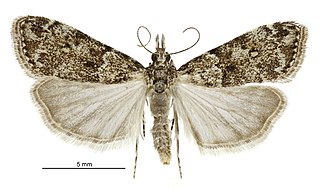
Eudonia subditella is a moth in the family Crambidae. It was described by Francis Walker in 1866. This species is endemic to New Zealand.



















